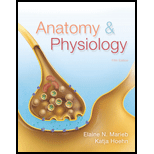
Concept explainers
What distinguishes the innate defense system from the adaptive defense system?
To review:
The first line of defense against disease.
Introduction:
The immune system is aptly defined as the defense system of the body. As it protects the body from most infectious microorganisms, cancer cells, and transplanted organs and grafts. Immune system defends by two ways - directly (by cell attack) and indirectly (by releasing chemicals and protective antibody molecules).
Explanation of Solution
Surface barriers such as skin and intact mucous membranes prevent entry of pathogens in the body and form the first line of defense against disease. The epithelial membrane is a formidable physical barrier to most of the organisms. Keratin which is a type of protein is found to be resistant mostly to weak acids and bases as well as to bacterial enzymes and toxins. The lining of mucous membranes in the form of intact mucosae provides mechanical barriers within the body. As mucous membrane line all body cavities that open to the exterior end such as the reproductive, digestive, respiratory, and urinary tracts. The significance of the first line of the defense system is to keep the invaders out of the body.
Besides being serving as physical barriers, skin and mucous membranes also produce a variety of protective chemicals in the following forms:
Defensins – A small amount of broad-spectrum antimicrobial peptides secreted through mucous membranes and skin are called defensins. In response to inflammation when surface barriers are breached, defensin output increases at a high rate. Defensins also help in controlling bacterial and fungal colonization in the exposed areas by causing disruption of microbial membranes.
Acid – The acidity (acid mantle) of skin, stomach, and vaginal secretions inhibits the growth of the bacterial growth.
Mucin – Mucin when dissolved in water, it forms a thick, sticky mucus which lines the respiratory and digestive passageways. As mucus traps microorganisms. In the similar manner, mucin in watery saliva traps microorganisms and washes them out of the mouth into the stomach where they are digested. Mucus-coated hairs inside the nose trap inhaled particles and cilia present on the mucosa of the upper respiratory tract help to move dust and bacteria laden mucus towards the mouth, preventing it from entering the lower respiratory tract and its passages.
Enzymes – Lysozyme (present in saliva), respiratory mucus, and lacrimal fluid of the eye – it destroys the bacteria. Protein-digesting enzymes in the stomach also responsible for destroying many microorganisms.
Other chemicals – Some lipids in sebum and dermcidin in eccrine sweat cause toxicity in bacteria.
Therefore, it can be concluded that the primary defense mechanism against various infectious disease is the surface barriers, which prevent pathogens from entering the body. These surface barriers include the mucous membranes andintact skin. They release the chemical secretions that are responsible for restricting the growth of microbes on their surfaces. Therefore, if pathogens cannot enter the body of the host, they cannot disrupt normal the physiological functions and cause disease.
Want to see more full solutions like this?
Chapter 20 Solutions
Anatomy & Physiology
- What symbolic and cultural behaviors are evident in the archaeological record and associated with Neandertals and anatomically modern humans in Europe beginning around 35,000 yBP (during the Upper Paleolithic)?arrow_forwardDescribe three cranial and postcranial features of Neanderthals skeletons that are likely adaptation to the cold climates of Upper Pleistocene Europe and explain how they are adaptations to a cold climate.arrow_forwardBiology Questionarrow_forward
- ✓ Details Draw a protein that is embedded in a membrane (a transmembrane protein), label the lipid bilayer and the protein. Identify the areas of the lipid bilayer that are hydrophobic and hydrophilic. Draw a membrane with two transporters: a proton pump transporter that uses ATP to generate a proton gradient, and a second transporter that moves glucose by secondary active transport (cartoon-like is ok). It will be important to show protons moving in the correct direction, and that the transporter that is powered by secondary active transport is logically related to the proton pump.arrow_forwarddrawing chemical structure of ATP. please draw in and label whats asked. Thank you.arrow_forwardOutline the negative feedback loop that allows us to maintain a healthy water concentration in our blood. You may use diagram if you wisharrow_forward
- Give examples of fat soluble and non-fat soluble hormonesarrow_forwardJust click view full document and register so you can see the whole document. how do i access this. following from the previous question; https://www.bartleby.com/questions-and-answers/hi-hi-with-this-unit-assessment-psy4406-tp4-report-assessment-material-case-stydu-ms-alecia-moore.-o/5e09906a-5101-4297-a8f7-49449b0bb5a7. on Google this image comes up and i have signed/ payed for the service and unable to access the full document. are you able to copy and past to this response. please see the screenshot from google page. unfortunality its not allowing me attch the image can you please show me the mathmetic calculation/ workout for the reult sectionarrow_forwardIn tabular form, differentiate between reversible and irreversible cell injury.arrow_forward
 Human Biology (MindTap Course List)BiologyISBN:9781305112100Author:Cecie Starr, Beverly McMillanPublisher:Cengage Learning
Human Biology (MindTap Course List)BiologyISBN:9781305112100Author:Cecie Starr, Beverly McMillanPublisher:Cengage Learning Human Physiology: From Cells to Systems (MindTap ...BiologyISBN:9781285866932Author:Lauralee SherwoodPublisher:Cengage Learning
Human Physiology: From Cells to Systems (MindTap ...BiologyISBN:9781285866932Author:Lauralee SherwoodPublisher:Cengage Learning Biology: The Dynamic Science (MindTap Course List)BiologyISBN:9781305389892Author:Peter J. Russell, Paul E. Hertz, Beverly McMillanPublisher:Cengage Learning
Biology: The Dynamic Science (MindTap Course List)BiologyISBN:9781305389892Author:Peter J. Russell, Paul E. Hertz, Beverly McMillanPublisher:Cengage Learning Principles Of Radiographic Imaging: An Art And A ...Health & NutritionISBN:9781337711067Author:Richard R. Carlton, Arlene M. Adler, Vesna BalacPublisher:Cengage Learning
Principles Of Radiographic Imaging: An Art And A ...Health & NutritionISBN:9781337711067Author:Richard R. Carlton, Arlene M. Adler, Vesna BalacPublisher:Cengage Learning Medical Terminology for Health Professions, Spira...Health & NutritionISBN:9781305634350Author:Ann Ehrlich, Carol L. Schroeder, Laura Ehrlich, Katrina A. SchroederPublisher:Cengage Learning
Medical Terminology for Health Professions, Spira...Health & NutritionISBN:9781305634350Author:Ann Ehrlich, Carol L. Schroeder, Laura Ehrlich, Katrina A. SchroederPublisher:Cengage Learning





